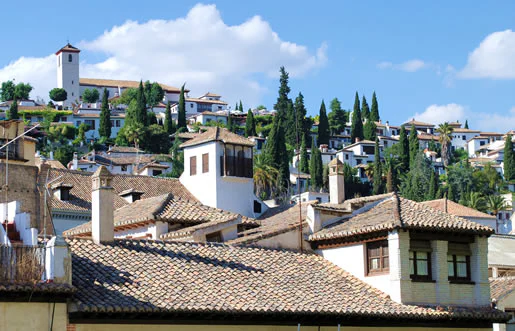Patio of the Lions
The Patio of the Lions (Patio de los Leones) is probably the most famous place of the Alhambra. It is so called because of the twelve lions that throw jets of water and which are part of the fountain in the middle of the patio. The big dodecagon-shaped basin rests on top of these twelve lions that are around it. This white marble fountain is one of the most important examples of Muslim sculpture. A poem by Ibn Zamrak was carved on the border of the basin. At the beginning of the 17th century another basin was added and is currently in the Garden of the Ramparts (Jardín de los Adarves), as well as the jet, which was done later, as indicated in the engraving.
This patio was built by order of Mohammed V, its ground plan is rectangular and it is surrounded by a gallery in the style of a Christian cloister. It does not follow the typical Muslim Andalusian patio style, more like the Court of the Myrtles (Patio de los Arrayanes). The gallery is supported by 124 white marble columns with fine shafts, which are decorated on the exterior side with many rings and which support cubic capitals and big abacuses, decorated with inscriptions and stylised vegetal forms. Under the wood carving frieze there are plaster arches, except for those of the pavilions and the ends of the longer sides of the galleries, which are of mocarabes, with scallops decorated with rhombus-shaped carvings. At the middle of each of the two longer sides of the patio there is a semicircular arch bigger than the rest of the arches and with archivolts of mocarabes and scallops decorated with styled vegetal forms. These arches lead to the Hall of the Abencerrajes (Sala de los Abencerrajes) and with the Hall of the Two Sisters (Sala de Dos Hermanas). The chambers where the sultan's wives lived are over the arches. At the middle of each of the shorter sides there is a pavilion, built on part of the patio. The pavilions' ground plan is square and they are covered with semispherical domes with a wooden interior.
In the centre of the patio there was a low garden and the galleries' floor is made out of white marble. The garden went through many alterations over the years and it has now been eliminated in order to avoid the dampness it may cause. There are white marble channels, which start inside the pavilions and inside the halls of the two other sides and which get together at the central fountain forming a cross. On the ends of the channels there are jets that send water to the central fountain.
Read more about...



